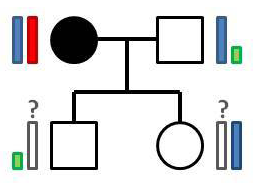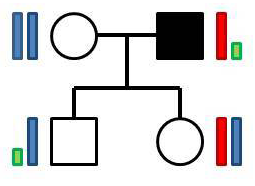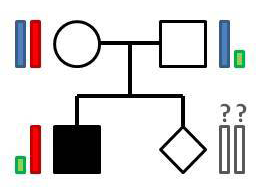Risk calculation of x-linked recessive inheritance
In diseases caused by X-linked recessive inheritance we often see affected sons of unaffected mothers, due to the fact that a woman carrying a disease-causing mutation in the heterozygous state is healthy (since she has one normal allele), whereas her son, if inheriting the mutation from her, will be hemizygous for the mutation and affected (as he only has one X chromosome and this carries the mutation). The risk that the son of a heterozygous woman becomes affected is thus 50%. The daughter of a woman heterozygous for an X-linked recessive disorder will not develop the disorder (unless we have one of those rare cases where her father has the same disorder), but her carrier risk can be calculated by dividing her mother’s carrier risk by 2. If a man is affected with an X-linked recessive disorder he will pass on the mutation to all of his daughters, but not to any of his sons, as they receive a Y chromosome from him. The mother of an affected man is a heterozygous carrier, which means that his sisters have 50% risk of being carriers too.

Figure 1. A pedigree showing x-linked recessive inheritance with the mother carrying the disease-causing mutation.

Figure 2. A pedigree showing x-linked recessive inheritance with the father carrying the disease-causing mutation.

Figure 2. A pedigree showing x-linked recessive inheritance with the sibling carrying the disease-causing mutation.